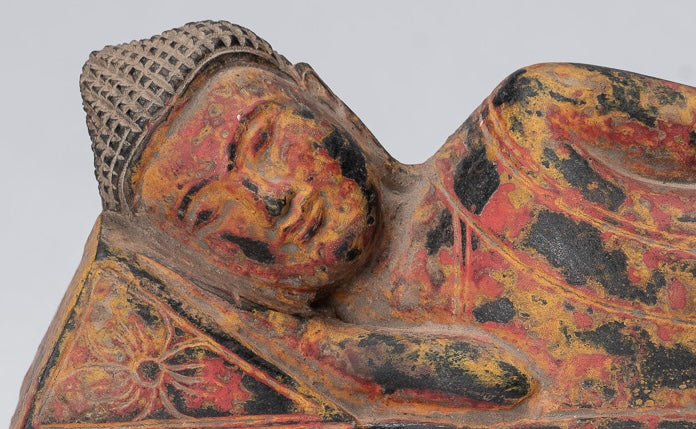
The Importance of the Nirvana Buddha in Thai Buddhism: A Symbol of Ultimate Liberation
In the rich and diverse tapestry of Thai Buddhism, various representations of the Buddha embody different aspects of his teachings and life. Among these, the Nirvana Buddha holds a place of profound significance.
Depicting the Buddha in his final moments of physical existence, the Nirvana Buddha symbolizes the ultimate liberation from the cycle of birth, death, and rebirth.
This blog post explores the meaning, historical context, iconography, and cultural importance of the Nirvana Buddha in Thai Buddhism, highlighting its role in shaping the spiritual landscape of Thailand.
Understanding Nirvana in Buddhism
Nirvana, or Nibbana in Pali, is the ultimate goal in Buddhism. It signifies the cessation of all suffering, desire, and individual existence, marking the end of the cycle of samsara (rebirth). Achieving Nirvana means attaining a state of perfect peace, wisdom, and liberation. For Buddhists, it represents the pinnacle of spiritual practice and the fulfillment of the Buddha’s teachings.
The Nirvana Buddha: Meaning and Symbolism
The Nirvana Buddha, also known as the Reclining Buddha, depicts Siddhartha Gautama in the final moments before his parinirvana, the complete and final passing away of the Buddha after his death. This image represents the Buddha's ultimate release from the physical world and his entrance into Nirvana.
In Thai Buddhism, the Nirvana Buddha holds deep symbolic meaning. It serves as a powerful reminder of the impermanence of life and the potential for liberation from suffering. The image of the Buddha lying peacefully on his side, often with a serene expression, embodies the tranquility and liberation that come with the attainment of Nirvana.
Historical Context and Development
The depiction of the Nirvana Buddha can be traced back to ancient India, with early representations found in the art and architecture of various Buddhist cultures. As Buddhism spread to Southeast Asia, the image of the Reclining Buddha was embraced and adapted by local traditions, including those in Thailand.
The influence of the Nirvana Buddha in Thailand grew significantly during the Sukhothai and Ayutthaya periods, when Thai artisans began creating large and elaborately decorated statues of the Reclining Buddha. These statues became integral to Thai temple architecture and religious practices, cementing the image’s importance in Thai Buddhism.
Iconography of the Nirvana Buddha
The Nirvana Buddha is characterized by specific iconographic features that convey its spiritual significance:
-
Posture: The Buddha is depicted lying on his right side, with his head supported by his right hand. This posture represents the moment of his parinirvana, reflecting his peaceful transition from the physical world to Nirvana.
-
Expression: The face of the Nirvana Buddha typically shows a calm and serene expression, symbolizing the inner peace and liberation attained through enlightenment.
-
Attire and Ornaments: The Buddha is often shown wearing simple monastic robes, emphasizing his renunciation of worldly attachments. In some representations, especially in Thailand, the statue may be adorned with intricate patterns and decorations, reflecting local artistic styles.
-
Accompanying Figures: In some temples, the Nirvana Buddha is surrounded by disciples or celestial beings, who are depicted mourning his passing or paying homage. These figures highlight the significance of the Buddha’s teachings and the impact of his enlightenment on the world.
Cultural and Religious Significance in Thailand
The Nirvana Buddha holds a central place in Thai religious and cultural life. Its significance can be seen in various aspects of Thai Buddhism:
-
Temple Architecture: Many Thai temples, or wats, feature a large statue of the Reclining Buddha as a focal point of worship. Notable examples include Wat Pho in Bangkok, home to one of the largest and most famous Reclining Buddha statues in Thailand.
-
Rituals and Festivals: The image of the Nirvana Buddha plays a key role in Buddhist rituals and festivals. During important events such as Visakha Bucha Day, which commemorates the birth, enlightenment, and death of the Buddha, devotees gather around the statue to offer prayers, flowers, and incense.
-
Meditation and Reflection: The serene presence of the Nirvana Buddha serves as an inspiration for meditation and reflection on the teachings of the Buddha. Devotees often meditate in front of the statue, contemplating the nature of impermanence and the path to liberation.
-
Cultural Identity: The Nirvana Buddha is deeply woven into the cultural identity of Thailand. Its image is widely recognized and revered, symbolizing the enduring influence of the Buddha’s teachings on Thai society and values.
Conclusion
The Nirvana Buddha is a profound symbol of ultimate liberation and spiritual awakening in Thai Buddhism. It represents the culmination of the Buddha's journey and the realization of Nirvana, offering a powerful reminder of the impermanence of life and the potential for liberation from suffering.
Through its historical, cultural, and religious significance, the Nirvana Buddha continues to inspire devotion, reflection, and spiritual practice in Thailand, embodying the timeless wisdom and compassion of the Buddha’s teachings.
As Thai Buddhists venerate the Nirvana Buddha, they connect with a rich tradition that guides them towards inner peace and ultimate enlightenment.


